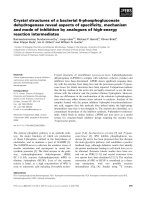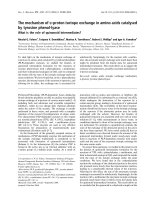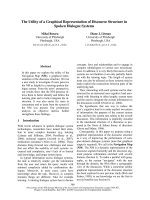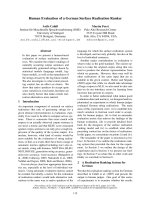báo cáo khoa học: " Two-stimuli manipulation of a biological motor" ppsx
Bạn đang xem bản rút gọn của tài liệu. Xem và tải ngay bản đầy đủ của tài liệu tại đây (528.38 KB, 4 trang )
BioMed Central
Page 1 of 4
(page number not for citation purposes)
Journal of Nanobiotechnology
Open Access
Short Communication
Two-stimuli manipulation of a biological motor
Zorica Ristic
1
, Marco Vitali
2,5
, Alessandro Duci
3
, Christian Goetze
3
,
Klaus Kemnitz
4
, Werner Zuschratter
2
, Holger Lill
1
and Dirk Bald*
1
Address:
1
Department of Molecular Cell Biology, VU University Amsterdam, Amsterdam, the Netherlands,
2
Leibniz-Institute for Neurobiology,
Magdeburg, Germany,
3
arivis Multiple Imaging Tools, Rostock, Germany,
4
EuroPhoton, Berlin, Europhoton, Berlin, Germany and
5
Technical
University Berlin, Germany
Email: Zorica Ristic - ; Marco Vitali - ; Alessandro Duci - ;
Christian Goetze - ; Klaus Kemnitz - ; Werner Zuschratter - ;
Holger Lill - ; Dirk Bald* -
* Corresponding author
Abstract
F
1
-ATPase is an enzyme acting as a rotary nano-motor. During catalysis subunits of this enzyme
complex rotate relative to other parts of the enzyme. Here we demonstrate that the combination
of two input stimuli causes stop of motor rotation. Application of either individual stimulus did not
significantly influence motor motion. These findings may contribute to the development of logic
gates using single biological motor molecules.
Findings
Biological nano-scale motors fulfil a broad range of tasks
in living cells. Some motors like myosin, kinesin and
dynein move in linear fashion. Other motors perform
rotary motion, e.g. the bacterial flagellar motor or the
enzyme F
1
-ATPase. F
1
-ATPase hydrolyses ATP into ADP
and inorganic phosphate. It is the smallest biological
rotary motor known, with a total molecular mass of ~400
kDa and the core subunits α
3
β
3
γ [1-3]. During enzymatic
catalysis subunit γ rotates within the hexagonal α
3
β
3
domain. This rotary movement has been microscopically
monitored by attachment of large probes such as fluores-
cently labelled actin filaments and polymer microspheres
to subunit γ [4-7]. In addition to plain motor observation,
also manipulation of motor movement has been
reported. Rotation in reverse direction was imposed on F
1
-
ATPase using magnetic tweezers [8,9]. Furthermore, rotor
movement was successfully modulated by chemical sig-
nals, including redox-switching [10,11], builtin Zn-sensi-
tive switches [12], small organic molecules [13-15] as well
as by temperature control [16,17]. However, these experi-
ments describe the response of F
1
to individual stimuli
and do not reveal how simultaneously acting stimuli are
processed by the motor.
Here we report manipulation of the F
1
-ATPase motor
movement at single molecule level by concerted optical
and chemical input stimuli. We combined an optical
stimulus (high-intensity illumination) with a chemical
stimulus (rhodamine 6G), on the rotary movement of sin-
gle F
1
molecules.
Biotin-PEAC maleimide was purchased from Dojindo
(Kumamoto, Japan). Streptavidin-coated microspheres
Published: 15 May 2009
Journal of Nanobiotechnology 2009, 7:3 doi:10.1186/1477-3155-7-3
Received: 17 February 2009
Accepted: 15 May 2009
This article is available from: />© 2009 Ristic et al; licensee BioMed Central Ltd.
This is an Open Access article distributed under the terms of the Creative Commons Attribution License ( />),
which permits unrestricted use, distribution, and reproduction in any medium, provided the original work is properly cited.
Journal of Nanobiotechnology 2009, 7:3 />Page 2 of 4
(page number not for citation purposes)
(mean diameter: 510 nm) were from Bangs Laboratories,
Inc. (Fishers, Indiana, USA). Other chemicals were of the
highest grade commercially available.
Preparation of F1-ATPase
The α
3
β
3
γ core complex of F
1
-ATPase originating from
Bacillus PS3 was prepared as previously described in [10]
and hereinafter referred to as F
1
-ATPase. The enzyme was
over-expressed in Escherichia coli strain JM103 uncB-D
using the pkkHC5 expression plasmid [10]. This plasmid
codes for the α, β, and γ subunits of the thermophilic
Bacillus PS3 F1-ATPase, carrying a decahistidine tag at the
N terminus of the β subunit and the mutation
γSer106→Cys.
Rotation Assay
F
1
-ATPase was biotinylated at a single cysteine residue in
subunit γ using biotin-(PEAC)5-maleimide (Dojindo,
Japan), as described elsewhere [10]. The biotinylated F
1
-
ATPase (30 nM) in an assay mixture containing 10 mM 3-
(N-Morpholino) propanesulfonic acid (MOPS)/KOH
(pH 7.0), 50 mM KCl and 2 mM MgCl
2
(buffer A) was
infused into a flow cell, constructed from microscope
cover slips as described [4], and incubated for 5 min to
allow for immobilization. The flow cell was washed with
100 μl of Buffer A supplemented with 10 mg/ml bovine
serum albumin (buffer B). Subsequently, a suspension of
streptavidin-coated polystyrene beads (Bangs Laborato-
ries, diameter 510 nm) suspended in Buffer B was infused
and incubated for 15 min. Next, 100 μl of reaction buffer
(Buffer B supplemented with 2 mM ATP, 4 mM MgCl
2
, 2.5
mM phosphoenolpyruvate, and 0.1 mg/ml pyruvate
kinase (Roche Applied Science) in the absence or in the
presence 100 μM Rhodamine 6G (Merck) was infused and
microscopic observation was started. Rotation of beads
was observed under bright field illumination with an
inverted fluorescence microscope (TI Eclipse, Nikon)
equipped by a Nikon Plan. Apo. 100× (N.A. 1.4) objec-
tive. Images were recorded with an Andor iXon DU-897BI
EMCCD camera (Andor Technology, Belfast, UK) at 25 Hz
frame rate. Image analysis was done using self made track-
ing routines under Matlab (The MathWorks, Natick, USA)
and the open-source image analysis software ImageJ.
Bright field illumination was performed by an attenuated
100W Halogen lamp (35 mW/cm/
2
on the sample).
High illumination intensity of the probe was performed
by 110 W Mercury lamp in epi-fluorescence illumination.
The excitation wavelength was selected by a 540 ± 10 nm
interference filter.
Motor movement in absence of input stimuli
ATP-driven rotation of F
1
-ATPase subunit γ was visualized
by attachment of a bead to the γ subunit (Fig. 1a) [7,11],
typical time courses of the rotational movement of two
molecules F
1
are shown in Fig. 1b. Rotation of both single-
bead as well as duplex-beads was unidirectional, continu-
ous and directions were always counter-clockwise when
viewed from top (Fig. 1b, [6]). Bead rotation occasionally
displayed pauses and subsequently resumed rotation.
These pauses have been described previously and may be
attributed to transient inhibition of F
1
by Mg-ADP
[18,19].
Motor response to concerted chemical and physical input
Next, we determined the motor response to concerted
physical and chemical stimuli. Illumination of the sam-
ples with light at 540 ± 10 nm for 5–10 sec at maximum
Rotary movement of F
1
-ATPase motorFigure 1
Rotary movement of F
1
-ATPase motor. (A) Schematic
view of the experimental system for the observation of F
1
-
ATPase rotation [7,11]. The polystyrene bead (diameter 0.51
μm) is connected to the F1 motor (not to scale). (B) Time
course of F
1
-ATPase rotation. Typical traces for single beads
(dashed line) and duplex beads (straight line) bound to one
F
1
-ATPase molecule are shown.
$
%
0
50
100
150
200
250
300
350
400
0 20406080100120
time (sec)
revolutions
DUPLEX
SINGLE
His- tag
β
ββ
β
β
ββ
β
α
αα
α
β
ββ
β
ATP
γ
γγ
γ
COVERSLIP
Journal of Nanobiotechnology 2009, 7:3 />Page 3 of 4
(page number not for citation purposes)
intensity (110 W/cm
2
) in the presence of rhodamine 6G
lead to a complete arrest of motor movement within the
duration of the light pulse (Fig. 2a). This light-induced
motor response was highly reproducible and observed for
>90% of all investigated motor molecules (n = 20), with
"motor arrest" defined as <1 revolution per minute of a
single or a duplex bead. These results indicate that rota-
tion of the F
1
-motor can be stopped by the combination
of an optical and a chemical input signal.
Motor response to individual input variables
We have observed a dramatic response of F
1
-ATPase
motor movement to two combined inputs. Next, we
assessed the two inputs imposed separately on the rotat-
ing motor. Firstly we tested the effect of high light inten-
sity on F
1
rotation in the absence of rhodamine 6G.
Typically, no significant effect on motor movement was
detected (Fig. 2b), only <10% of the observed F
1
– ATPase
molecules (n = 22) stopped upon illumination.
Subsequently we evaluated the effect of the chemical
input (rhodamine 6G) alone on motor movement. As
depicted in Fig. 2b, rhodamine 6G alone did not signifi-
cantly influence motor rotation (<10% of n = 20 observed
molecules arrested). Turnover of ATP by F
1
-ATPase in
bulk-phase is influenced by rhodamine 6G and related
lipophilic cations [20-28]. Whereas, low concentrations
of rhodamine stimulate F
1
-ATPase (up to 10 μM), higher
concentrations lead to enzyme inhibition [20,21]. Rhod-
amine 6G at higher concentration is believed to bind F
1
-
ATPase at least at two binding sites [20-28]. High intensity
illumination may cause photoreactions that modulate the
affinity of rhodamine 6G for F
1
-ATPase [29-31].
We have demonstrated that the movement of a biological
motor can be arrested by synergistic inputs of optical and
chemical stimuli. Motor arrest is observed at single mole-
cule level and does not occur when the input stimuli are
applied separately. The motor response reported here is is
consistent with a function as an "AND" logic gate in terms
of producing a single output on two concerted inputs [32-
34]. For full implementation of a motor protein "AND"
gate, reversibility of the motor system response is an
important factor. Experiments to gain a deeper under-
standing of the response mechanism and to improve
reversibility are on-going in our laboratory. Biomolecules
acting as "AND" gates in bulk-phase have been described
earlier, e.g. light dependent release of an unfolded fluores-
cent protein from a chaperone protein [34], or an
enzyme-based logic gate [35]. Extending the work of these
authors, our results may help to develop motor protein-
based logic gates, operating and monitored at the single
molecule level.
Competing interests
The authors declare that they have no competing interests.
Authors' contributions
ZR performed motor labelling and microscopic observa-
tion, MV prepared the microscope set-up and took
images, AD and CG carried out image analysis, KK, WZ HL
and DB conceived the experiments, DB coordinated the
study. All authors read and approved the final manuscript.
Manipulation of F
1
rotor motion by optical and chemical inputsFigure 2
Manipulation of F
1
rotor motion by optical and chem-
ical inputs. Sequential images of a rotating beads before and
after a pulse (10 sec) of high intensity white light illumination
(white bar) in the presence (A) or absence (B) of rhodamine
6G. (C) Rotating beads in the presence of rhodamine 6G, but
without light pulse.
$
%
2c
Publish with Bio Med Central and every
scientist can read your work free of charge
"BioMed Central will be the most significant development for
disseminating the results of biomedical research in our lifetime."
Sir Paul Nurse, Cancer Research UK
Your research papers will be:
available free of charge to the entire biomedical community
peer reviewed and published immediately upon acceptance
cited in PubMed and archived on PubMed Central
yours — you keep the copyright
Submit your manuscript here:
/>BioMedcentral
Journal of Nanobiotechnology 2009, 7:3 />Page 4 of 4
(page number not for citation purposes)
Acknowledgements
Financial support provided by the European Commission (Marie-Curie
project MRTN-CT-2005-019481 "From FLIM to FLIN") is gratefully
acknowledged.
References
1. Abrahams JP, Lesli AGW, Lutter R, Walker JE: Structure at 2.8 Å
resolution of F1-ATPase from bovine heart mitochondria.
Nature 1994, 370:621-628.
2. Kinosita K Jr, Adachi K, Itoh H: Rotation of F1-ATPase: How an
ATPdriven molecular machine may work. Annu Rev Biophys Bio-
mol Struct 2004, 33:245-268.
3. Von Ballmoos C, Cook GM, Dimroth P: Unique Rotary ATP Syn-
thase and its Biological Diversity. Annu Rev Biophys 2008,
37:43-64.
4. Noji H, Yasuda R, Yoshida M, Kinosita K Jr: Direct observation of
the rotation of F1-ATPase. Nature 1997, 386:299-302.
5. Hisabori T, Kondoh A, Yoshida M: The γ subunit in chloroplast
F1-ATPase can rotate in a unidirectional and counter-clock-
wise manner. FEBS Letters 1999, 463:35-38.
6. Noji H, Häsler K, Junge W, Kinosita K Jr, Yoshida M, Engelbrecht S:
Rotation of Escherichia coli F(1)-ATPase. Biochem Biophys Res
Commun 1999, 260(3):597-9.
7. Yasuda R, Noji H, Yoshida M, Kinosita KJr, Itoh H: Resolution of
distinct rotational substeps by submillisecond kinetic analy-
sis of F
1
-ATPase. Nature 2001, 410:898-904.
8. Itoh H, Takahashi A, Adachi A, Noji H, Yasuda R, Yoshida M, Kinosita
K: Mechanically driven ATP synthesis by F
1
-ATPase. Nature
2004, 427:465-468.
9. Rondelez Y, Tresset G, Nakashima T, Kato-Yamada Y, Fujita H,
Takeuchi S, Noji H: Highly coupled ATP synthesis by F1-
ATPase single molecules. Nature 2005, 433(7027):773-7.
10. Bald D, Noji H, Stumpp MT, Yoshida M, Hisabori T: ATPase activ-
ity of a highly stable alpha(3)beta(3)gamma subcomplex of
thermophilic F(1) can be regulated by the introduced regu-
latory region of gamma subunit of chloroplast F(1). J Biol
Chem 2000, 275(17):12757-62.
11. Bald D, Noji H, Yoshida M, Hirono-Hara Y, Hisabori T: Redox Reg-
ulation of the Rotation of the F1-ATP Synthase. J Biol Chem
2001, 276(43):39505-39507.
12. Liu H, Schmidt JJ, Bachand GD, Rizk SS, Looger LL, Hellinga HW,
Montemagno CD: Control of a biomolecular motor-powered
nanodevice with an engineered chemical switch. Nat Mater
2002, 1:173-177.
13. Groth G, Hisabori T, Lill H, Bald D: Substitution of a single amino
acid switches the tentoxin-resistant thermophilic F1-
ATPase into a tentoxinsensitive enzyme. J Biol Chem 2002,
277(23):20117-20119.
14. Pavlova P, Shimabukuro K, Hisabori T, Groth G, Lill H, Bald D: Com-
plete Inhibition and Partial Re-activation of Single F1-
ATPase Molecules by Tentoxin. J Biol Chem 2004,
279:9685-9688.
15. Meiss E, Konno H, Groth G, Hisaboru T: Molecular Processes of
Inhibition and Stimulation of ATP Synthase Caused by the
Phytotoxin Tentoxin. J Biol Chem. 2007, 283(36):24594-24599.
16. Yamagushi S, Matsumoto S, Ishizuka K, Iko Y, Tabata KV, Arata HF,
Fujita H, Noji H, Itaru H: Thermally responsive supramolecular
nanomesches for on/off switching of rotary motion of F1-
ATPase at the single molecule level. Chem Eur J 2008,
14:1891-1896.
17. Furuike S, Adachi K, Sakaki N, Shimo-Kon R, Itoh H, Muneyuki E,
Yoshida M, Kinosita K Jr: Temperature Dependence of the
Rotation and Hydrolysis Activities of F
1
-ATPase. Biophys J
2008, 95:761-770.
18. Jault JM, Dou C, Grodsky NB, Matsui T, Yoshida M, Allison WS: The
alpha3beta3gamma subcomplex of the F1-ATPase from the
thermophilic bacillus PS3 with the betaT165S substitution
does not entrap inhibitory MgADP in a catalytic site during
turnover. J Biol Chem 1996, 271(15):28818-28824.
19. Hirono-Hara Y, Noji H, Nishiura M, Muneyuki E, Hara KY, Yasuda R,
Kinosita K Jr, Yoshida M: Pause and rotation of F(1)-ATPase
during catalysis. Proc Natl Acad Sci 2001, 98(24):13649-13654.
20. Paik SR, Yokogama M, Yoshida M, Ohta T, Kagawa Y, Allison WS:
The TF1-ATPase and ATPase Activities of Assembled α
3
β
3
γ,
α
3
β
3
γδ and α
3
β
3
γε Complexes are Stimulated by Low and
Inhibited by High Concentrations of Rhodamine 6G
Whereas the Dye Only Inhibits the α
3
β
3
, and α
3
β
3
δ Com-
plexes. J Bioenergeties and Biomembranes 1993, 25(6):679-684.
21. Gledhill JR, Walker JE: Inhibition sites in F1-ATPase from
bovine heart mitochondria. Biochemical Journal 2005,
386:591-598.
22. Allison WS, Jault JM, Zhuo S, Paik SR: Functional sites in F1-
ATPase: localication and interactions. J Bioenergeties and
Biomembranes 1992, 24(5):469-477.
23. Grodsky NB, Allison WS: The adenine pocket of a single cata-
lytic site is derivatized when the bovine heart mitochondrial
F
1
-ATPase is photoinactivated with 4-amino-1-octyl-
quinaldinium. Cell Biochemistry and Biophysics 1999, 31(3):285-294.
24. Bullogh DA, Ceccarelli EA, Roise D, Allison Ws: Inhibition of the
bovineheart mitochondrial F1-ATPase by cationic dyes and
amphipathic peptides. Biochim Biophys Acta 1989, 975:377-383.
25. Wieker HJ, Kuschmitz D, Hess B: Inhibition of yeast mitochon-
drial F1-ATPase, F0F1-ATPase and submitochondrial parti-
cles by rhodamines and ethidium bromide. Biochim Biophys Acta
1987, 892:108-117.
26. Gear LR: Rhodamine 6G. JBC 1984, 249:3628-3637.
27. Higuti T, Nijmi S, Sajto R, Nakasima S, Ohe T, Tani I, Yoshimura T:
Rhodamine 6G, inhibitor of both H+-ejections from mito-
chondria energized with ATP and with respiratory sub-
strates. Biochim Biophys Acta 1980, 593:463-467.
28. Hong S, Pedersen PL: ATP Synthase and the Actions of Inhibi-
tors Utilized To Study Its Roles in Human Health, Disease,
and Other Scientific Areas. Microbiology and Molecular Biology
Reviews 2008:590-641.
29. Xu XH, Yeung ES: Direct Measurement of Single-Molecule Dif-
fusion and Photodecomposition in Free Solution. Science
1997, 275(5303):1106-1109.
30. Windegren J, Chmyrov A, Eggeling C, Löfdahl PA, Seidel CA: Strat-
egies to improve photostabilities in ultrasensitive fluores-
cence spectroscopy. J Phys Chem A 2007, 111(3):429-440.
31. Fernàndez-Suárez M, Ting AY: Fluorscent probes for super-reso-
lution imaging in living cells. Nat Rev Mol Cell Biol 2008,
9(12):929-943.
32. De Silva AP, Uchiyama S: Molecular logic and computing. Nat
Nanotechnol 2007, 2:399-410.
33. Willner I, Shlyahovsky B, Zayats M, Willner B: DNAzymes for sens-
ing, nanotechnologoly and logic gate applications. Chem Soc
Rev 2008,
37:1153-1165.
34. Muramatsu S, Kinbara K, Taguchi H, Ishii N, Aida T: Semibiological
molecular machine with an implemented "AND" logic gate
for regulation of protein folding. J Am Chem Soc 2006,
128(11):3764-9.
35. Sivan S, Tuchman S, Lotan N: A biochemical logic gate using an
enzyme and its inhibitor. Part II: The logic gate. BioSystems
2003, 70:21-33.







![Tài liệu Báo cáo khoa học: Specific targeting of a DNA-alkylating reagent to mitochondria Synthesis and characterization of [4-((11aS)-7-methoxy-1,2,3,11a-tetrahydro-5H-pyrrolo[2,1-c][1,4]benzodiazepin-5-on-8-oxy)butyl]-triphenylphosphonium iodide doc](https://media.store123doc.com/images/document/14/br/vp/medium_vpv1392870032.jpg)

